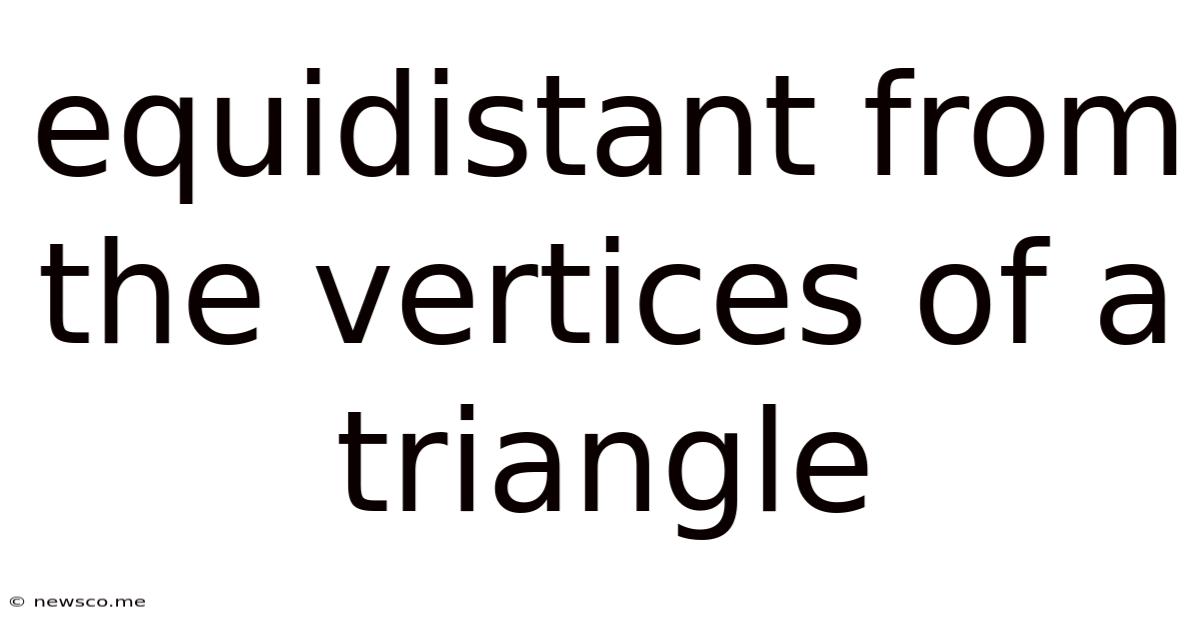Equidistant From The Vertices Of A Triangle
News Co
May 08, 2025 · 5 min read

Table of Contents
Equidistant from the Vertices of a Triangle: Exploring the Circumcenter and Other Geometric Wonders
The concept of a point equidistant from the vertices of a triangle is a fundamental idea in geometry with far-reaching implications. Understanding this concept opens doors to exploring fascinating geometric properties and relationships, leading to a deeper appreciation of spatial reasoning. This article delves into the details of this concept, exploring the circumcenter, its properties, and its connections to other important points within a triangle. We'll also examine how this concept extends to other geometric shapes and its applications in various fields.
Understanding the Circumcenter
The point equidistant from the vertices of a triangle is known as the circumcenter. It's the center of the circumcircle, a circle that passes through all three vertices of the triangle. This implies that the circumcenter is located at the intersection of the perpendicular bisectors of the sides of the triangle. This intersection point is unique for any given triangle, except for degenerate cases (such as a triangle with collinear vertices).
Constructing the Circumcenter
The circumcenter can be constructed using a compass and straightedge. The process involves constructing the perpendicular bisectors of at least two sides of the triangle. The intersection of these bisectors defines the circumcenter. Let's break this down:
-
Perpendicular Bisector Construction: For each side of the triangle, we construct its perpendicular bisector. This involves finding the midpoint of the side and then drawing a line perpendicular to the side at that midpoint.
-
Intersection Point: The point where the perpendicular bisectors intersect is the circumcenter. Since all three perpendicular bisectors are concurrent (intersect at a single point), constructing only two is sufficient to locate the circumcenter.
-
Circumcircle: With the circumcenter located, we can draw the circumcircle using the circumcenter as the center and the distance to any vertex as the radius.
Properties of the Circumcenter
The circumcenter possesses several key properties that make it a significant point in geometry:
-
Equidistant from Vertices: This is the defining property: the circumcenter is equidistant from each of the triangle's vertices. This distance is the radius of the circumcircle.
-
Intersection of Perpendicular Bisectors: The circumcenter is the intersection of the perpendicular bisectors of the triangle's sides. This is a crucial construction method.
-
Circumradius: The distance from the circumcenter to any vertex is called the circumradius, denoted by R. The circumradius is related to the triangle's area (A) and sides (a, b, c) by the formula:
R = abc / 4A. -
Location Dependent on Triangle Type: The location of the circumcenter relative to the triangle varies depending on the type of triangle:
- Acute Triangle: The circumcenter lies inside the triangle.
- Right Triangle: The circumcenter lies on the hypotenuse (midpoint of the hypotenuse).
- Obtuse Triangle: The circumcenter lies outside the triangle.
The Circumcenter and Other Notable Triangle Points
The circumcenter is intimately related to other important points within a triangle, including the centroid, orthocenter, and incenter. Understanding these relationships provides a richer understanding of a triangle's geometric properties.
Circumcenter vs. Centroid
The centroid is the center of mass of the triangle, located at the intersection of the medians (lines connecting each vertex to the midpoint of the opposite side). While both points are located within the triangle for acute triangles, they are distinct points with different properties and geometric significances.
Circumcenter vs. Orthocenter
The orthocenter is the intersection point of the altitudes (perpendicular lines from each vertex to the opposite side). The relationship between the circumcenter and orthocenter is particularly interesting: they are isogonal conjugates. This means that the lines connecting a vertex to the circumcenter and the orthocenter form equal angles with the sides of the triangle that meet at that vertex.
Circumcenter vs. Incenter
The incenter is the center of the incircle (the circle inscribed within the triangle), located at the intersection of the angle bisectors. Unlike the circumcenter which is always equidistant from the vertices, the incenter is equidistant from the sides of the triangle.
Applications of the Circumcenter
The concept of the circumcenter and its related properties finds application in various fields:
-
Computer Graphics: The circumcenter plays a crucial role in algorithms for rendering and manipulating 3D models and shapes.
-
Engineering: In structural engineering, understanding the circumcenter is valuable when analyzing the stability and stress distribution in triangular structures.
-
Surveying: The circumcenter is utilized in surveying to determine precise locations and distances.
-
Navigation: Principles related to the circumcenter can be applied to navigation systems and geographic information systems (GIS).
Extending the Concept to Other Shapes
While the concept of a point equidistant from the vertices is specifically defined for triangles, similar concepts extend to other geometric shapes. For example, in a quadrilateral, the point equidistant from the vertices (assuming such a point exists) isn't necessarily the center of a circumscribed circle. The properties and existence of such points vary significantly depending on the type of quadrilateral.
Conclusion
The circumcenter, the point equidistant from the vertices of a triangle, is a cornerstone of geometry. Its construction, properties, and relationships with other notable triangle points provide a rich landscape for exploration and application. Understanding this concept leads to a deeper appreciation of geometric principles and opens avenues for solving complex problems in various fields, from computer graphics to structural engineering. The seemingly simple concept of equidistance from vertices of a triangle hides a surprising depth and utility within the world of geometry and beyond. Further exploration into its related theorems and applications will undoubtedly reveal even more fascinating insights into the mathematical world.
Latest Posts
Related Post
Thank you for visiting our website which covers about Equidistant From The Vertices Of A Triangle . We hope the information provided has been useful to you. Feel free to contact us if you have any questions or need further assistance. See you next time and don't miss to bookmark.